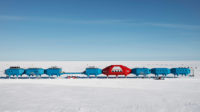Colorado Firm Designs New Antarctic Research Base

The angular forms of glaciers inspired the shape of the buildings.
Rendering courtesy OZ Architecture

A large glazed opening in the multipurpose lecture hall frames views of the landscape.
Rendering courtesy OZ Architecture


Architects & Firms
OZ Architecture has designed hospitals in Rwanda, resorts in China, and buildings of almost every type across the country. But one of the firm’s current projects has taken architects a bit farther afield.
The Denver-based firm has redesigned the master plan for the U.S. Antarctic research base McMurdo Station—the largest outpost (and biggest of three such American facilities) on the world’s southernmost continent. Commissioned in fall 2012 by the National Science Foundation (NSF) and Leidos (formerly Lockheed Martin), which manages the logistics for the NSF’s Polar Outreach Program, OZ’s scheme will dramatically improve the efficiency, sustainability, and livability of the compound for its 250 to 1,000 inhabitants. (While a skeleton crew lives there year-round, most staff work from October to March, during the Antarctic summer.)
“This is a curious project for us to have,” admits Rick Petersen, a principal with OZ. “We didn’t have any history of working down there.” But the firm did have expertise designing the separate components of the base—office, residential, food service, recreation facilities—and the clients “were looking for a fresh perspective,” says Petersen, who calls the project the “commission of a lifetime.”
Established in 1955, McMurdo comprises more than 100 structures. “A lot of energy was spent moving things from one building to the next,” says Petersen. The efficiency of the new plan comes from consolidating the smaller volumes into six large ones; situating related spaces near each other (for example, food storage will now be adjacent to the kitchen, not in a separate facility); and enclosing connections between the new core buildings, “so you don’t have to stop and take your boots off.”
This streamlining benefits sustainability at the station, which is heated and powered primarily by diesel generators. (Wind turbines provide a third of the base’s electricity, but, given the limited sunlight, photovoltaics are not a viable option.) OZ’s design improves the buildings’ skin-to-volume ratio and applies a high-performance building envelope (R-72) to walls, ceilings, and floors. “In a way, we are making a Thermos bottle,” says Petersen.
Corridors, which can be kept at lower temperatures, are on the perimeter of buildings—further reducing heat loss—along with strategically placed triple-glazed windows, which are also found in key communal spaces, like the dining hall. “People are drawn to this special place, but at the current McMurdo, you really don’t get a sense of the beauty and grandeur of it,” explains Petersen, who has visited the site twice. “Now you’ll have amazing views as you move from one part of the station to the next.”
Temperatures at the base vary from minus 40 degrees Fahrenheit to a relatively balmy 40 degrees above zero, so the master plan still includes some outdoor walkways between buildings. “It was important we provide options within this enclosed campus, where, sometimes, you can’t or shouldn’t get out for days on end.” New dormitories, to house up to 850 people, are all single-occupancy rooms, versus shared bunks at the current base. “Everyone is down there to do one thing—support the science,” says Petersen, who notes that for every scientist, there are nine support staff. “No one wants to take a sick day because their roommate gave them a cold.”
Construction supplies will arrive by sea in the station’s annual cargo shipment each January. “One of our first questions from a design standpoint was how big is the shipping container?” Petersen recalls. With that constraint in mind, the firm specified, for example, premanufactured wall panels.
Now that OZ Architecture has completed design development, a design-build contractor will execute the project. Peter T. West, the NSF’s Polar Outreach Program Manager, tells RECORD that the agency hopes construction will begin by September 2019; it will take approximately five years to complete.






